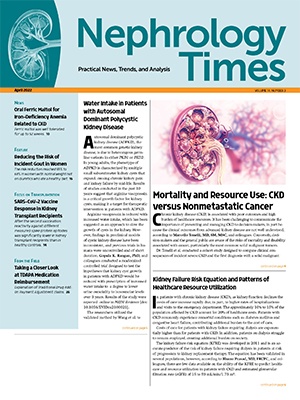
Even after accounting for socioeconomic factors and comorbid medical conditions, kidney disease develops at younger age among Black Americans than among other racial/ethnic groups and Black Americans are three times more likely to progress to end-stage kidney disease (ESKD). DNA sequence variants that are associated with an increase in the risk of kidney disease (including one in the hemoglobin b locus (HBB), sickle cell trait, and apolipoprotein L-1 (APOL1) are more common among Black Americans, but do not fully explain the racial diversity in kidney disease.
According to A. Parker Ruhl, MD, MHS and colleagues, Black Americans and other minority populations are underrepresented in many large-scale longitudinal US population studies, hindering investigations into kidney disease and other chronic diseases.
Previous studies have identified nitric oxide signaling as important as protection against and recovery from ischemic or oxidative injury to the kidney, yet there are few data available on associations between genetic variants in nitric oxide signaling pathways in the kidney and kidney function or kidney disease. Results of some studies have suggested a-globin as a regulator of nitric oxide signaling in the endothelial cells of small resistance arteries.
a-Globin is expressed by the HBA1 and HBA2 genes that are organized in tandem on chromosome 16. The gene (HBA) copy number is variable in people of African descent and other populations worldwide. The sequence similarity of the HBA1 and HBA2 genes makes them susceptible to deletions, which are common among people from Africa, Southeast Asia, the Pacific Islands, and the Mediterranean. This depletion spans part of the HBA2 and HBA1 genes and reduces the functional gene copy number by one, resulting in a decrease in total a-globin gene (HBA) expression in red cell precursors.
Dr. Ruhl et al. conducted a national longitudinal cohort study to test the hypothesis that, given the protective effect of nitric oxide in the kidney, there would be associations between a-globin gene deletions and protection against prevalent CKD, incident reduced estimated glomerular filtration rate (eGFR), and incident ESKD among Black Americans. Results were reported in the Journal of the American Society of Nephrology [2022;33(1):213-224].
The cohort included participants from the REGARDS (Reasons for Geographic and Racial Differences in Stroke) study that was designed to determine the reasons for racial disparities in stroke and cognitive decline in Black and White Americans ≥45 years of age. Of the 30,239 participants enrolled from 2003 to 2017, 41% (n=12,514) were Black and were from states considered to be in the stroke belt, where stroke incidence is highest in the United States.
HBA copy number was measured as a numeric variable with values of 2, 3, 4, 5, or 6 as determined by droplet digital PCR (ddPCR) analysis of genomic DNA. The ddPCR copy number assay targeted a unique sequence within the 3.7-kb insertion/deletion polymorphism. The copy number of the target relative to a reference gene was determined.
The prevalence of CKD was defined by an eGFR <60 mL/min/1.73 m2 or a urine albumin-creatinine ratio ≥30 mg/g or at baseline. Modified Poisson multivariable regression was used to calculate the prevalence ratio of CKD and the relative risk of incident reduced eGFR. Cox proportional hazards multivariable regression was used to calculate the hazard ratio of incident ESKD. Analyses were adjusted for demographic, clinical, and genetic risk factors.
Following application of inclusion and exclusion criteria, the cohort for the current analysis included 9908 patients. Of those participants, 4% (n=393) had two HBA copies, 28% (n=2744) had three HBA copies, 67% (n=6668) had four HBA copies, 1% (n=101) had five HBA copies, and <1% (n=2) participants had six HBA copies.
In adjusted analysis, there was an association between a one-copy increase in HBA and 14% greater prevalence of CKD (prevalence ratio, 1.14; 95% confidence interval [CI], 1.07-1.21; P<.0001). The prevalence of CKD increased with HBA copy number. Among participants with two HBA copies, CKD prevalence was 20%; among those with three copies, 25%; among those with four copies, 25%; and among those with five or more copies, CKD prevalence was 35%. Red blood cell parameters varied according to HBA copy number (P<.0001): a hypochromic, microcytic anemia was seen in participants with two copies of HBA.
The association between HBA copy number and incident reduced eGFR was analyzed in 3733 participants who were evaluated at a second in-home visit. Following adjustment for relevant factors, there was no association between HBA copy number and incident reduced eGFR (relative risk, 1.06; 95% CI, 0.94-1.19; P=.38).
Of the 9905 participants included in the ESKD analysis, 342 developed ESKD over a median of 10.7 years of follow-up. In adjusted analysis, there was no significant association between HBA copy number and the hazard of incident ESKD (hazard ratio [HR], 1.07; 95% CI, 0.88-1.29; P=.50). In an analysis adjusted for 13 factors selected a priori, there was an association between each additional copy of HBA and a 32% increase in the hazard of incident ESKD (HR, 1.32; 95% CI, 1.06-1.61; P=.005).
The researchers cited the lack of an independent replication cohort as a limitation to the study findings.
In conclusion, the authors said, “We report that higher HBA copy number was independently associated with greater CKD prevalence and ESKD incidence after accounting for known clinical, demographic, and genetic risk factors in this national longitudinal study of Black Americans. The high frequency of HBA gene deletion found in Black Americans may act to reduce the overall burden of kidney disease in this population.”
Takeaway Points
- Researchers reported results of a study designed to test the hypothesis that a-globin gene (HBA) deletions would be associated with protection against prevalent chronic kidney disease (CKD), incidence reduced estimated glomerular filtration rate (eGFR), and incident end-stage kidney disease (ESKD) among Black Americans.
- Among 9908 participants, the prevalence of CKD increased with HBA copy number.
- In an adjusted subgroup analysis of 9905 participants, there was association between each additional copy of HBA and a 32% increase in the hazard of incident ESKD.







 © 2025 Mashup Media, LLC, a Formedics Property. All Rights Reserved.
© 2025 Mashup Media, LLC, a Formedics Property. All Rights Reserved.